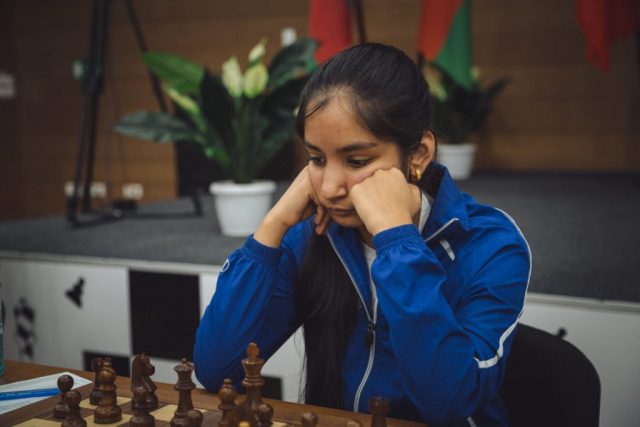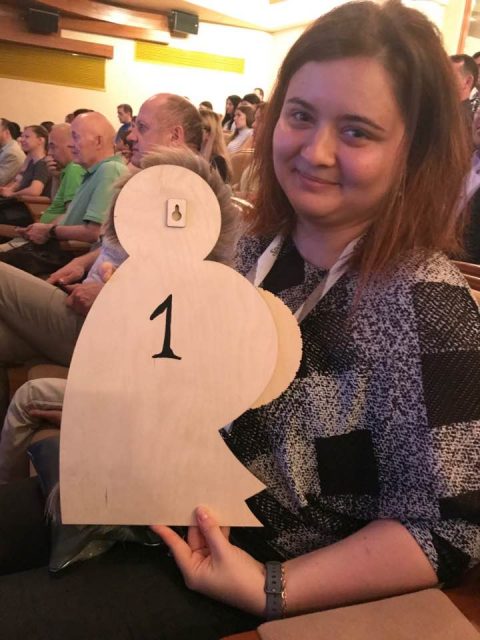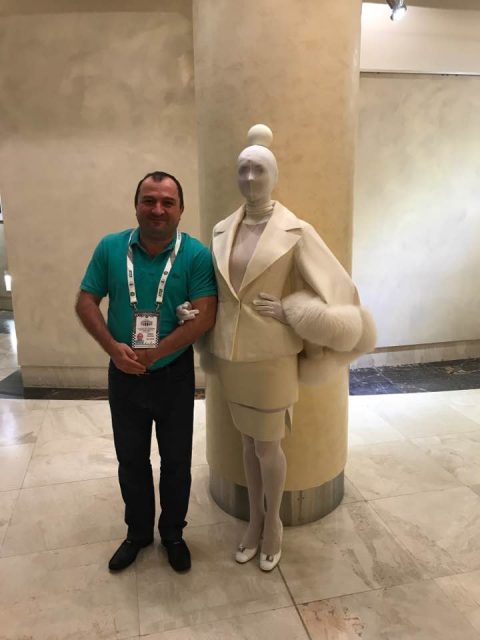The United States entry in the 2017 World Team Championship has spent the first half of the competition stumbling around like extras from The Walking Dead and finds itself tied with Ukraine for 6th and 7th after five rounds. Currently leading are Russia ahead of China, Poland and a surprising Turkish team.
The U.S. team entered the World Team seeded in the middle and with hopes of improving on its performances in 2011 and 2015. In each of those events the American team was seeded near the bottom, but over achieved and tied for fourth. The team will need to have a dramatic turn around to match these performances and it will require every player to find better form.
Going into the event the team realized playing in Khanty Mansiysk, Russia, was not going to be easy as our top three players were committed to Norway Chess and the Grand Chess Tour. The city of 80,000, located not far from the confluence of the Ob and Irtysh rivers, is well known through the chess world for hosting major competitions. The administrative center for Russian oil fields in Western Siberia, it is a prosperous, definitely much wealthier than the average Russian city, but it is not easy to get to.
The Turkish first board Dragan Solak took the scenic 43-hour train ride from Moscow to a small town hear Surgut, before catching a ride from some Chechens for the final four hour car ride to Khanty Mansiysk, but the American team opted to fly. This entailed a 10-14 hour journey to Moscow from the U.S., a 10-15 hour layover in Moscow and then a 1:50 am flight to Khanty from Sheremetyevo (for some reason the flights only leave in the wee hours of the morning). We factored in the two nights lost sleep, but hoped that arriving three days early would help to adjust to the 10-12 time zone difference. Unfortunately after accepting the invitation the organizers decided to start the event one day earlier and it was too expensive for us to change the tickets for an earlier departure.
The team has been trying its hardest, but sleeping has been difficult, especially as it has been hot most of our stay and the hotel doesn’t have air conditioning. Leaving windows open is a double-edged proposition as mosquitoes and much larger bugs seem to like American blood. There is also the issue of sunlight. This far north it never gets completely dark so blackout curtains are provided, but using them leaves the room hot and stuffy.
This combination of circumstances has been especially difficult for the veterans on the team, Varuzhan Akobian and Alex Onischuk. Both had tremendous U.S. Championships, with Onischuk tying for first with Wesley So and only losing in the playoff. Here Onischuk's excellent technique has not yet surfaced. Witness the following game from round five from the match with Belarus where Alex almost loses a position that is his bread and butter. Excuses are easy to make, but play over this game and you will better understand how the U.S. team has suffered. After three hours of this match it looked like we would likely win 2 ½ - 1 ½ with 3-1 even possible - Sam was better and had 30 minutes while his opponent was playing on the increment. The worst case had to be 2-2, but we ended up lucky not to lose this match!
 Akshita Gorti, Photo World Team website
Akshita Gorti, Photo World Team website
 Follow the World Team here and look for more from John and Melik upon the event's conclusion.
Follow the World Team here and look for more from John and Melik upon the event's conclusion.
[pgn]
[Event "World Team Chess Championship"]
[Site "Khanty-Mansiysk, RUS."]
[Date "2017.06.21"]
[Round "5.2"]
[White "Kovalev Vladislav (BLR)"]
[Black "Onischuk Alexander (USA)"]
[Result "1/2-1/2"]
[ECO "D02"]
[WhiteElo "2641"]
[BlackElo "2685"]
[PlyCount "230"]
[EventDate "2017.??.??"]
[Source "ChessBase"]
[SourceDate "2007.09.04"]
[WhiteClock "0:03:09"]
[BlackClock "0:07:18"]
1. d4 Nf6 2. Nf3 d5 3. Bf4 {When I started playing in 1972 the London System
and Giuoco Piano were considered openings suitable for only club players. How
times change! Now the best players in the world regularly employ both of these
openings hoping to avoid heavy preparation and just play chess.} c5 4. e3 Nc6
5. Nc3 (5. c3 {is the normal London, but the text, regularly used by Nakamura
and Jobava, is becoming more popular. The old axiom that the c-pawn should not
be blocked by a knight in queen pawn openings is broken so often these days it
should no longer be considered a rule.}) 5... Bg4 6. Be2 (6. dxc5 {has been
tried here, but doesn't present Black any problems.}) 6... e6 7. O-O Bxf3 (7...
Be7 {and}) (7... Rc8 {have also been tried, but the text makes a lot of sense.
Black takes away Ne5 and unbalances the position.}) 8. Bxf3 cxd4 9. exd4 Bd6
10. Be3 a6 11. Ne2 Qc7 12. g3 O-O 13. Nc1 b5 {Black has emerged from the
opening with equal chances and arranges his pieces and pawns as if he were
playing the White-side of the minority attack in the Queen's Gambit Declined.}
14. Nd3 b4 15. Kg2 Rfc8 16. Qe2 Qb6 17. Rfc1 Na5 18. b3 Nc6 19. Qd1 Ne7 20. a3
a5 21. axb4 axb4 22. Rxa8 Rxa8 23. Ra1 Rc8 24. Ra2 Nf5 25. Qa1 Nxe3+ (25... h5
{with the idea of taking on e3 later and following up with ...Qc7 and ...h4
was a decent alternative. This theme will appear later in the game.}) 26. fxe3
g6 27. Nc5 Qd8 28. Nb7 Qc7 29. Nxd6 Qxd6 30. Ra8 Qc6 31. Rxc8+ Qxc8 {Black has
emerged with a small but pleasant advantage. He has a target a c2 to attack
and his knight is the more flexible minor piece on the board.} 32. Qd1 h5 {
This grabs space and could be the prelude to a future ...h4 and ...hxg3
creating a second target on g3.} 33. Qd2 Qc7 34. Kf1 (34. Qxb4 Qxc2+ {would
increase Black's advantage as White's king and pawns would become weaker.})
34... Kg7 35. Ke1 Qa5 36. Qc1 g5 37. Kd2 g4 38. Bg2 h4 $1 39. Qf1 h3 $6 {
The text looks text tempting as it buries the bishop on h1, but a clear win
was to be had in} (39... Qc7 $1 {after the forced} 40. Qf4 (40. Qe1 Nh5) 40...
Qxf4 {Black wins after both recaptures:} 41. exf4 (41. gxf4 h3 42. Bh1 g3 43.
hxg3 Ne4+ 44. Ke1 Nxg3 45. Bf3 h2 46. Kf2 Nf5 47. Bh1 Kh6 48. Bf3 Nh4 49. Bh1
Kh5 50. Kg3 Nf5+ 51. Kf2 Kg4 52. Bf3+ Kh3 53. Bg2+ Kh4 54. Bh1 (54. e4 dxe4 55.
Bxe4 Kg4) 54... Ng3) 41... hxg3 42. hxg3 Nh5 43. c4 bxc3+ 44. Kxc3 Nxg3 45. b4
Kf8 {and the Black king is in time to stop the b-pawn.}) 40. Bh1 Qc7 (40... Nh5
{was a very interesting alternative} 41. e4 ({As} 41. Qe1 {allows Black to
realize his idea of totally imprisoning the bishop by taking away the e4 break
and then infiltrating with the queen. For example.} f5 42. Qf1 Qa2 43. Qd1 Nf6
44. Qf1 Qb2) 41... Qc7 42. exd5 Qc3+ 43. Kd1 Qxd4+ 44. Ke2 Qe5+ 45. Kf2 exd5 {
winning a pawn and the game.}) 41. Qd3 Qc6 (41... Nh5 42. c4 Nxg3 43. hxg3 Qxg3
44. Qe2 dxc4 45. bxc4 Qg1 46. Bb7 f5 {and the Black pawns cannot be stopped is
an idea that comes more easily to a computer.}) 42. Kc1 Kf8 43. Kb2 Ke7 {
Much of Black's advantage has disappeared, but it is hard to believe he would
ever be in danger of losing.} 44. Qd2 Qb5 45. Qe1 Qb6 46. Qe2 Qc7 47. Qd2 Qd6
48. Qe2 e5 {This and Black's next few moves all look very thematic but White
is still okay.} 49. dxe5 Qxe5+ 50. Kb1 d4 51. e4 Qg5 52. Qc4 Qd2 53. Qc5+ Kd8 (
53... Ke8 54. Qe5+ Kf8 55. Qxf6 Qe1+ 56. Kb2 Qxh1 57. Qd8+ Kg7 58. Qxd4+ Kg8 {
is also a draw. Black is losing some pawns but the passer on h2 saves him.})
54. Qb6+ Ke7 55. Qc5+ Kd8 56. Qa5+ Kc8 $2 (56... Kd7 57. Qf5+ Ke7 58. Qe5+ Kf8
59. Qxf6 Qxh2 {transposes to the line given earlier.}) 57. Qa6+ Kc7 58. Qxf6
Qe1+ 59. Kb2 Qc3+ 60. Kb1 Qe1+ 61. Ka2 Qxh1 62. Qxf7+ Kb6 63. Qe6+ Kc7 64. Qc4+
Kd7 65. Qxd4+ Ke8 66. Qe5+ Kd7 (66... Kf7 {as the king needs to be ready to
stop the e-pawn.}) 67. Qf5+ Kc7 68. Qf7+ Kc6 (68... Kd6 {was a better try.})
69. Qe6+ Kc7 70. Qe7+ Kc6 71. e5 Qxh2 72. Qd6+ Kb7 73. Qxb4+ Kc7 74. Qd6+ Kb7
75. Qd7+ (75. Qd3 $1 {wins as White discovers at move 87.}) 75... Kb6 76. Qe6+
Kb7 77. Qf7+ Kb6 78. Qe6+ Kb7 79. Qd5+ Kb6 80. Qd4+ Kc7 81. Qc5+ Kd7 82. Qd6+
Ke8 83. Qe6+ Kd8 84. Qf6+ Kc7 85. Qe7+ Kc6 86. Qd6+ Kb7 87. Qd3 $1 {White
finally hits on the winning idea.} Qg1 88. e6 h2 89. Qe4+ Kc7 90. e7 h1=Q 91.
Qxh1 Qxh1 92. e8=Q Qf3 {Alex said he would have resigned if it was not a team
tournament. White is easily winning if he takes some care.} 93. Qe5+ Kc6 94.
Kb2 Kb6 95. b4 Kb7 96. c3 Qd1 97. Qe4+ Kc7 98. c4 $2 {Alex thought this was
still winning but a practical mistake as the White king becomes more exposed.
His gut told him pushing the b-pawn after repositioning the queen is the right
idea.} Qd2+ 99. Kb3 Qd1+ 100. Qc2 Qf3+ 101. Qc3 Qd1+ 102. Ka3 (102. Kb2 Qe2+
103. Kc1 Qf1+ 104. Kc2 Qe2+ 105. Qd2 Qe4+ (105... Qxc4+ 106. Qc3) 106. Qd3 {
is the right way, but difficult to see with both players down to the 30 second
increment.}) 102... Qf3 103. Kb2 Qe2+ 104. Kb1 $4 ({This throws away the win.
White had to see the trick} 104. Kc1 Qf1+ 105. Kc2 Qe2+ 106. Qd2 {when the
pawn on c4 cannot be captured.}) 104... Qd1+ 105. Ka2 Qe2+ 106. Kb3 Qd1+ 107.
Ka2 Qe2+ 108. Qb2 {The only way to get out of the checks temporarily is to
give up a pawn, but the game is still drawn.} Qxc4+ 109. Qb3 Qe2+ 110. Ka3 Kb6
111. Qc3 Qf3 112. Kb2 Qg2+ 113. Kc1 Qf1+ 114. Kd2 Qf2+ 115. Kd1 Qf1+ {This
miracle looks like a good omen for the remaining rounds.} 1/2-1/2[/pgn]
Such a miracle has to be a good sign. After taking a 6 mile walk together on the free day and having a nice meal in the local Georgian restaurant, the team is ready for a strong finish the last four rounds.
The US Women's team is doing very well and has not been plagued by the jet-lag, since several players came directly from Europe to Khanty Mansisyk. They are currently tied for sixth through ninth which does not do justice to how well they have played.
The Russian and Chinese women entered the Women's World Team Championship as the clear favorites with average team ratings over 2500. Next up in the pre-tournament seedings are Georgia, Poland, India and Ukraine who are all well over 2400 FIDE per board. The US is seeded near the bottom with Vietnam and Azerbaijan at around 2350. That has not stopped them from competing hard in every match and their score of one match win, two draws (with Russia and Poland) and two losses (1 1/2 - 2 1/2 to Ukraine and India) could easily be two wins and three draws. Anna Zatonskih has been a rock on board one (+1, =4) and teenager Akshita Gorti terrific in her debut on the national team with one win and three draws against significantly stronger opposition. All teams members are in good form and captain and coach Melik Khachiyan has been doing an exceptional job.
 Akshita Gorti, Photo World Team website
Akshita Gorti, Photo World Team website [pgn] [Event "FIDE Women's World Team Championship"] [Site "chess24.com"] [Date "2017.06.18"] [Round "2.4"] [White "Vijayalakshmi, Subbaraman"] [Black "Gorti, Akshita"] [Result "1/2-1/2"] [WhiteElo "2375"] [BlackElo "2240"] [PlyCount "52"] [EventDate "2017.??.??"] [WhiteTeam "India"] [BlackTeam "United States"] [WhiteTeamCountry "IND"] [BlackTeamCountry "USA"] [WhiteClock "0:07:35"] [BlackClock "0:05:21"] 1. d4 e6 2. c4 Nf6 3. a3 b6 4. Nc3 Bb7 5. Nf3 d5 6. Bg5 Be7 7. Qa4+ Qd7 8. Qc2 dxc4 9. e3 Bxf3 10. gxf3 b5 11. Bxf6 gxf6 12. a4 c6 13. axb5 cxb5 14. Qe4 Nc6 15. Nxb5 Rb8 16. Nc3 Rxb2 17. Bxc4 f5 18. Qf4 Bb4 19. Rc1 Rg8 20. Bd3 e5 21. Qh6 exd4 22. Qxh7 Rg6 23. Qh8+ Ke7 24. Qh4+ Ke8 25. Qh8+ Ke7 26. Qh4+ Ke8 1/2-1/2 [/pgn]On their round five draw against Russia, Captain Khachiyan said, "Our preparation was good, both chess and mentally...we have a big heart and a spirit of all for one!" Khachiyan also pinpointed this defensive success by Nemcova in the Russia match.
[pgn] [Event "FIDE Women's World Team Championship"] [Site "chess24.com"] [Date "2017.06.21"] [Round "5.3"] [White "Goryachkina, Aleksandra"] [Black "Nemcova, Katerina"] [Result "1/2-1/2"] [WhiteElo "2477"] [BlackElo "2313"] [PlyCount "178"] [EventDate "2017.??.??"] [WhiteTeam "Russia"] [BlackTeam "United States"] [WhiteTeamCountry "RUS"] [BlackTeamCountry "USA"] [WhiteClock "0:00:57"] [BlackClock "0:02:47"] 1. d4 d5 2. c4 dxc4 3. Nf3 a6 4. e3 b5 5. a4 Bb7 6. b3 e6 7. bxc4 bxc4 8. Bxc4 Nf6 9. O-O c5 10. Nbd2 cxd4 11. Nxd4 Nc6 12. N4f3 Bb4 13. Bb2 O-O 14. Qe2 Qe7 15. Bd3 Rfd8 16. Nc4 Na5 17. Nce5 Nc6 18. Rac1 Nxe5 19. Nxe5 Bd6 20. Rfd1 a5 21. Nc6 Bxc6 22. Rxc6 Rac8 23. Rxc8 Rxc8 24. g3 h6 25. Bb1 Ba3 26. Qa6 Re8 27. Bxa3 Qxa3 28. Qxa5 Nd5 29. Qb5 Kf8 30. Bc2 Nc3 31. Qd3 Rc8 32. Qa6 Qc5 33. Re1 Rc6 34. Qa8+ Rc8 35. Qb7 Rc7 36. Qb8+ Rc8 37. Qb7 Rc7 38. Qa8+ Rc8 39. Qf3 Qb4 40. Kg2 Qc4 41. a5 Nd5 42. Be4 Qc3 43. Rd1 Qxa5 44. Bxd5 exd5 45. Rxd5 Qc7 46. h4 Rd8 47. Rf5 g6 48. Rb5 h5 49. Rb4 Qe5 50. Rf4 Rd7 51. Kh2 Kg7 52. Qe2 Re7 53. Qd2 Kg8 54. Rd4 Re8 55. Rd8 Rxd8 56. Qxd8+ Kh7 57. Qd4 Qf5 58. Kg2 Kg8 59. Kf1 Qb1+ 60. Ke2 Qc2+ 61. Qd2 Qf5 62. Qd3 Qg4+ 63. Kf1 Qh3+ 64. Ke1 Qe6 65. Qd4 Qf5 66. e4 Qe6 67. Kd2 Qb3 68. Ke2 Kh7 69. Qd5 Qc2+ 70. Kf3 Qc3+ 71. Kg2 Kg7 72. Qg5 Qd4 73. Qf4 Qd1 74. Qe5+ Kg8 75. Qf6 Qd7 76. Qe5 Kh7 77. Qd5 Qc7 78. e5 Qe7 79. Kf3 Kg7 80. Qd6 Qb7+ 81. Kf4 Qa7 82. Qf6+ Kh7 83. Kg5 Qd7 84. f3 Qe8 85. Qd6 Qa8 86. Qf6 Qf8 87. Kf4 Qb4+ 88. Ke3 Qc3+ 89. Ke4 Qc4+ 1/2-1/2 [/pgn]
 Follow the World Team here and look for more from John and Melik upon the event's conclusion.
Follow the World Team here and look for more from John and Melik upon the event's conclusion.Categories
Archives
- December 2025 (27)
- November 2025 (29)
- October 2025 (39)
- September 2025 (27)
- August 2025 (29)
- July 2025 (43)
- June 2025 (25)
- May 2025 (24)
- April 2025 (29)
- March 2025 (29)
- February 2025 (20)
- January 2025 (24)
- December 2024 (34)
- November 2024 (18)
- October 2024 (35)
- September 2024 (23)
- August 2024 (27)
- July 2024 (44)
- June 2024 (27)
- May 2024 (31)
- April 2024 (51)
- March 2024 (34)
- February 2024 (25)
- January 2024 (26)
- December 2023 (29)
- November 2023 (26)
- October 2023 (37)
- September 2023 (27)
- August 2023 (37)
- July 2023 (47)
- June 2023 (33)
- May 2023 (37)
- April 2023 (45)
- March 2023 (37)
- February 2023 (28)
- January 2023 (31)
- December 2022 (23)
- November 2022 (32)
- October 2022 (31)
- September 2022 (19)
- August 2022 (39)
- July 2022 (32)
- June 2022 (35)
- May 2022 (21)
- April 2022 (31)
- March 2022 (33)
- February 2022 (21)
- January 2022 (27)
- December 2021 (36)
- November 2021 (34)
- October 2021 (25)
- September 2021 (25)
- August 2021 (41)
- July 2021 (36)
- June 2021 (29)
- May 2021 (29)
- April 2021 (31)
- March 2021 (33)
- February 2021 (28)
- January 2021 (29)
- December 2020 (38)
- November 2020 (40)
- October 2020 (41)
- September 2020 (35)
- August 2020 (38)
- July 2020 (36)
- June 2020 (46)
- May 2020 (42)
- April 2020 (37)
- March 2020 (60)
- February 2020 (38)
- January 2020 (45)
- December 2019 (34)
- November 2019 (35)
- October 2019 (42)
- September 2019 (45)
- August 2019 (56)
- July 2019 (44)
- June 2019 (35)
- May 2019 (40)
- April 2019 (48)
- March 2019 (61)
- February 2019 (39)
- January 2019 (30)
- December 2018 (29)
- November 2018 (51)
- October 2018 (45)
- September 2018 (29)
- August 2018 (49)
- July 2018 (35)
- June 2018 (31)
- May 2018 (39)
- April 2018 (31)
- March 2018 (26)
- February 2018 (33)
- January 2018 (30)
- December 2017 (26)
- November 2017 (24)
- October 2017 (30)
- September 2017 (30)
- August 2017 (31)
- July 2017 (28)
- June 2017 (32)
- May 2017 (26)
- April 2017 (37)
- March 2017 (28)
- February 2017 (30)
- January 2017 (27)
- December 2016 (29)
- November 2016 (24)
- October 2016 (32)
- September 2016 (31)
- August 2016 (27)
- July 2016 (24)
- June 2016 (26)
- May 2016 (19)
- April 2016 (30)
- March 2016 (36)
- February 2016 (28)
- January 2016 (32)
- December 2015 (26)
- November 2015 (23)
- October 2015 (16)
- September 2015 (28)
- August 2015 (28)
- July 2015 (6)
- June 2015 (1)
- May 2015 (2)
- April 2015 (1)
- February 2015 (3)
- January 2015 (1)
- December 2014 (1)
- July 2010 (1)
- October 1991 (1)
- August 1989 (1)
- January 1988 (1)
- December 1983 (1)









